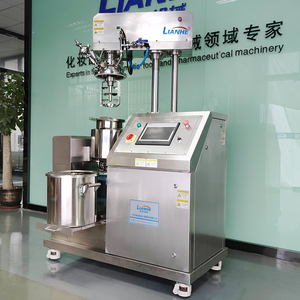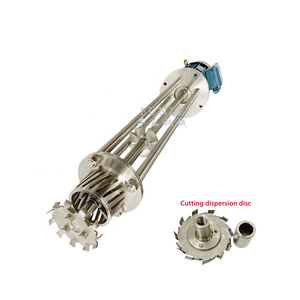
All categories
Featured selections
Trade Assurance
Buyer Central
Help Center
Get the app
Become a supplier

(1993 products available)




















Market Overview: The low shear mixer market is witnessing a steady growth trajectory, with the global market valued at approximately $755.6 million in 2023 and projected to reach $904.5 million by 2030, reflecting a compound annual growth rate (CAGR) of 2.6% during this period, according to Research and Markets. This growth is largely attributed to advancements in mixing technology and an increasing demand for high-quality products across various industries, including food and beverage, pharmaceuticals, and cosmetics. As consumer preferences shift towards premium and consistent products, manufacturers are compelled to invest in low shear mixing technologies that ensure product integrity without compromising texture or quality.
Regional Insights: The U.S. market for low shear mixers is estimated to be around $205.8 million in 2023, while China is anticipated to grow at a robust CAGR of 5.1%, reaching $180.3 million by 2030. These trends highlight the significant potential of the Asia-Pacific region, alongside established markets in North America and Europe. The market's expansion is influenced by the rise of automated production processes, which necessitate efficient mixing solutions. Additionally, as industries increasingly comply with stringent quality standards, the adoption of low shear mixers is expected to accelerate. Companies are also exploring niche markets and diversifying product offerings to address specific consumer needs, further driving the growth of low shear mixers in the coming years.
A low shear mixer comes in several types. Here are some of them:
Gentle Paddle or Spiral Mixers
These mixers have large mixing paddles or spirals that are fixed to a shaft. They rotate at low speeds, typically under 100 RPM. They stir the mixture gently, moving a small portion of the material up, down, and across the mixing chamber. This process cycles every few seconds. Low-speed paddle mixers are suitable for mixing fragile materials like cakes, which may break easily if processed by a high shear mixer. They are also ideal for integrating small amounts of additives into a bulk material.
Wide Blade or Paddle Mixers
These blends have wider metal paddles that gently mix the materials. They work great for mixing viscous materials with a thick consistency. If handled by a high shear mixer, such materials may need extended processing time. Wide blade mixers are used in the chemical industry to combine pastes, creams, and muds. They also mix heavy solids with liquids.
Airplane Propeller Mixers
These mixers have blades fixed to a base that connects to a motor. The blades rotate in a manner similar to an aircraft motor. They are used to mix materials that settle quickly or separate in the container. The mixer brings the batter up and down, scrapping the bottom of the container. This action prevents any material from settling at the bottom to create a homogenous mixture. It would take a high shear mixer a long time to achieve this result.
Rotamixer
This mixer relies on gravity and rotation to mix materials gently. It consists of a rotary vessel located horizontally in space. The vessel rotates in a circular motion with a low to moderate speed. While rotating, it discharges the material. The vessel also imparts a shearing force to the material, allowing for easy and gentle mixing. The amount of shearing force depends on the direction and speed of the vessel. A rotamixer is gentler on materials than a high shear mixer.
Ribbon Blenders
A ribbon blender consists of a large vessel with a ribbon-shaped blade inside. The ribbon moves material along the perimeter before drawing it back down to the center. This action results in a cohesive, homogenous mixture. The ribbon moves the material at a low speed, preventing excessive heat buildup or damage to the mixture. Ribbon blenders come in different sizes and models, and most of them are suitable for the food and pharmaceutical industry.
Low shear mixer specifications may vary depending on application needs, but here are some common ones.
Users can extend the machine's life by performing regular maintenance to avoid breakdown. Here are some parts that need to be checked and the corresponding procedure.
Low shear mixers are mostly used in industries where bulk mixing of viscous liquid and solid content is needed. Some of the primary usage applications are detailed below:
When choosing a low shear mixer for sale for industrial buyers' needs, several factors must be considered.
Product viscosity and density
It is essential to determine the size, weight, and density of the products that will be mixed. If the items are heavy and thick, a more robust mixer must be chosen to ensure that the final product will have the correct consistency.
BatcH or continuous mixing
Decide if batch or continuous mixing is needed. If a large quantity of products needs to be mixed at one time, a batch mixer will be more suitable. On the other hand, if only a small quantity is required continuously throughout the day, then a continuous mixer would be best.
Power source
Low shear mixers can be powered by air, electric, or hydraulic energy. If the mixer is to be used in an area that is at risk of explosion, a pneumatically powered mixer should be considered. However, for other uses, an electric motor is more efficient, and energy conversion from AC to DC is better.
Impeller design
Choose the right type of impeller for the task at hand. Certain types are more suitable for mixing sticky and cohesive items, while others work better for dispersing air or liquids into a product.
The construction material of the mixer
Depending on the item being mixed, a particular type of mixer construction is required. For example, a stainless steel mixer is best when a cleaning food-grade standard is required.
Noise levels
It is important to consider the noise levels that the mixing machine will produce and the workplace's legal requirements. Low shear mixers are generally quiet, but some models do produce a higher level of noise.
Ease of operation
Mash mixers with complicated control systems and numerous settings are normally more expensive and more difficult to use. Consider a product that will be simply operated and have intuitive controls.
Q1: What materials are low shear mixers typically made of?
A1: The body of a low shear mixer is typically made of stainless steel, such as 304 stainless steel. This material is ideal for low shear mixer construction because it is not only durable but also corrosion resistant. Stainless steel can stand the test of time, and that is why many low shear mixers remain functional for many decades. Depending on the applications, the low shear mixer might come with a stainless steel flap coated with Teflon.
Q2: Can a low shear mixer handle solids?
A2: In case it is flowing. Low shear mixers are ideal for handling fragile solids such as crumbly rock salts, marshmallows, and crystals. Therefore, they do not typically break down solid particles. Nonetheless, they can mix substances with solid materials that are not passively settled in the medium, such as sedimented solids at the bottom of the container.
Q3: How does the power requirement of a low shear mixer compare to a high shear mixer?
A3: Low shear mixers typically use less power than high shear mixers. This is because the low shear mixers have to stir slowly. Nevertheless, the power requirements of low shear mixers can vary depending on their sizes.